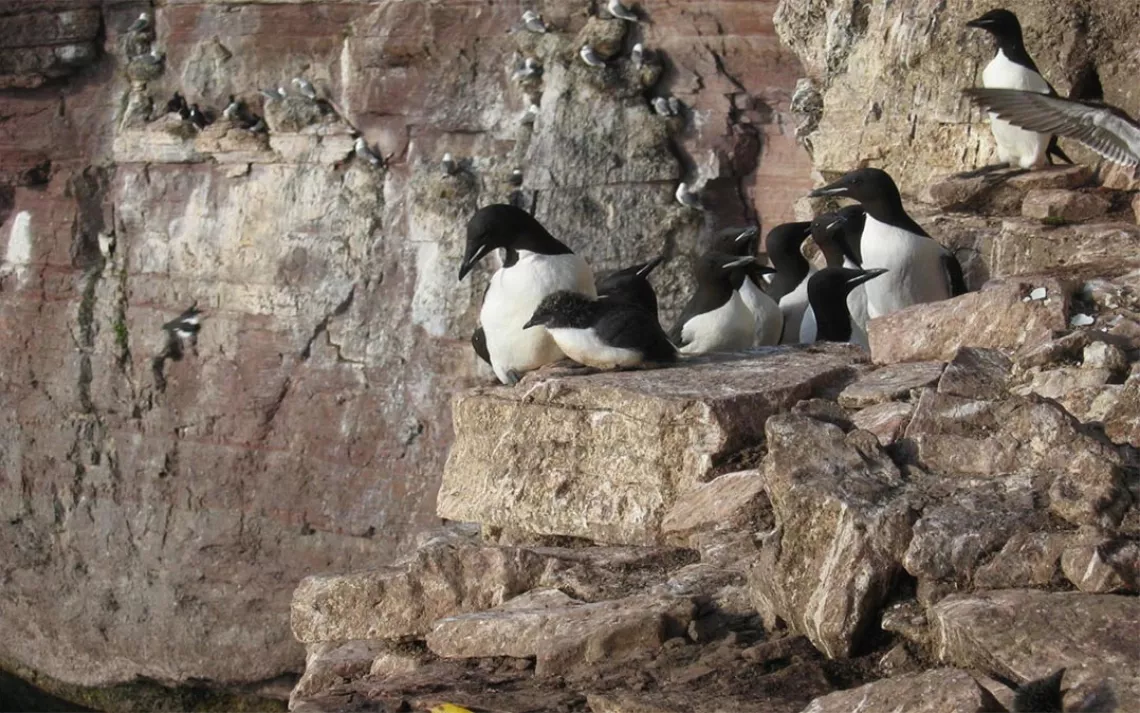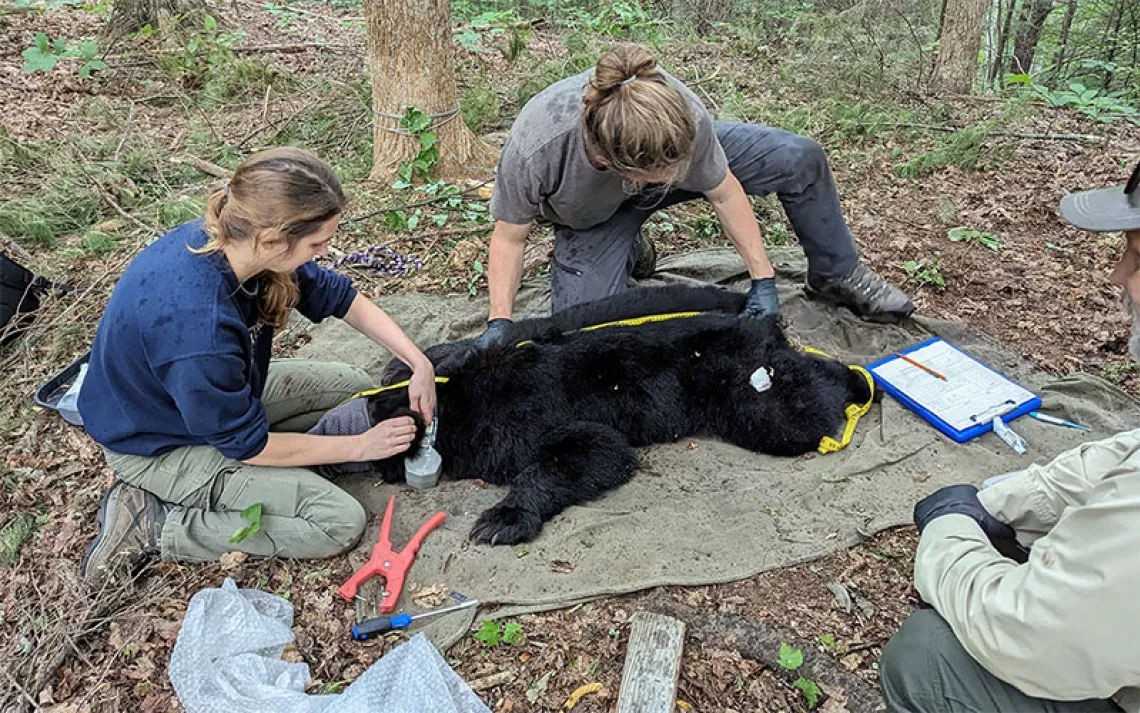Why Baby Murres Jump
Why do common murre chicks toss themselves off cliffs before they learn to fly?

Photo courtesy of Knud Falk
For a few days every August, when the seas around oceanside cliffs in northern territories like Greenland, Nunavut, and Newfoundland are calm, the skies fill with plummeting puffballs, as baby murres leap—sometimes falling hundreds of meters—toward their fathers waiting in the unexplored waters below. For decades, researchers have been uncertain whether the jump was an inspired leap of faith or some sort of cruel evolutionary joke. But new research in the journal The American Naturalist is helping to solve the ecological mystery.
Murres, which look like a cross between a penguin and a loon, are a pretty successful species, breeding on low-Arctic cliffs and in boreal waters all around the Northern Hemisphere. They are also pretty strange. Murres are often called the penguins of the North, but unlike penguins in Antarctica, which has no terrestrial predators, murres evolved while adapting to threats from arctic foxes and polar bears. That meant they kept a rudimentary ability to fly in order to nest on the relative safety of cliff ledges (though birds like eagles, gulls, and jaegers still pose a problem). Flying, however, is tough for murres; they have the highest “flight cost,” or energy expenditure, of any species. The young are also primarily raised by the father, which is unusual in the bird world.
But the jump is the murre’s strangest trick. Arctic ecologist and lead author of a new study, Kyle Elliott of McGill University, explains that some birds, like ducks and chickens, are precocious, able to scratch around looking for food right after they are born. The vast majority of birds, however, don’t leave the safety of the nest until they can fly and partially feed themselves. There are very few exceptions, but nothing like the murre, which leaps off its natal ledge when it is just about three weeks old, or a third of the way to adulthood. For decades, biologists hypothesized that the murres were making a Faustian bargain, trading safety for food. But Elliott’s research shows otherwise. “At sea the baby murres grow at a much faster rate. The father can hunt and feed the juvenile right there instead of flying to the colony. It’s like rather than having a parent drive back and forth to Costco, you could be living at Costco,” he says. “We believed the colony is a safer place. Out to sea, there are fish, sharks, walruses, and other predators that will feed on the murres.”
For the first time, Elliott was able to attach logging devices to the murres, keeping track of them throughout the breeding season. It turns out that the sea wasn’t any more dangerous than living on the cliff. So the baby murres might as well jump. “Once you know that there are both higher growth rates for the chicks at sea and similar survival rates compared with life in the colony, it then makes sense to see this seemingly death-defying leap as a win-win strategy when it comes to survival,” Elliott said in a statement.
 Photo by Kyle Elliott The jump also has advantages for the parents, who generally mate for life. Elliott’s trackers show that the attentive fathers were able to spend more time hunting when their offspring were with them, logging about 25 percent, or six hours a day, of their time fishing underwater versus 10 percent when they were constantly flying back to their young at the colony, wasting precious energy. And the mother, who expends most of her energy producing the relatively big single egg and rearing the chick in the first few weeks, is able to take a breather. In fact, while her family is away, female murres in the colony play the field, copulating with other birds and finding a side piece just in case their mate doesn’t return the next year.
Photo by Kyle Elliott The jump also has advantages for the parents, who generally mate for life. Elliott’s trackers show that the attentive fathers were able to spend more time hunting when their offspring were with them, logging about 25 percent, or six hours a day, of their time fishing underwater versus 10 percent when they were constantly flying back to their young at the colony, wasting precious energy. And the mother, who expends most of her energy producing the relatively big single egg and rearing the chick in the first few weeks, is able to take a breather. In fact, while her family is away, female murres in the colony play the field, copulating with other birds and finding a side piece just in case their mate doesn’t return the next year.
But there may be other factors at play as well when it comes to the jump. Rob Suryan, a marine ecologist at Oregon State University, has studied the effects of increased bald eagle predation on murre colonies in Oregon. In some areas, bald eagles—followed by scavenging vultures and gulls—disrupt breeding season so severely that entire colonies fail. While he finds Elliott’s research compelling, Suryan says that it’s also possible that the young murres jump to avoid predation from the sky, though that idea has not been tested. “In a large portion of its range in the Pacific, there are these predators,” he says. “Not only is it a possible benefit to head out to sea and provide a higher growth rate, but the chicks get off a vulnerable rock surface or colony available to predators.”
The entire breeding season only takes up about two months of the murres’ year. Elliott says that in future studies he hopes the new tracking technology will show more about what the father murres do the other 10 months at sea. Maybe they have bachelor parties.
 The Magazine of The Sierra Club
The Magazine of The Sierra Club






